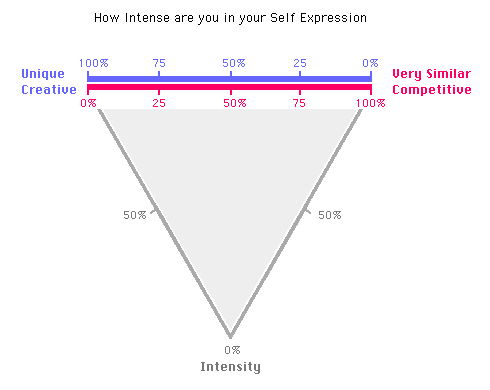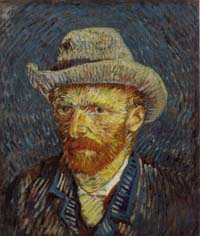21. Are you
unique or the same as everyone else?
------------------------
Previous - Next - Contents
In a general sense I believe that there are two
extreme positions
from which to see oneself in this world :
- as the same to
every other human
being in this world
The person who sees him/herself as the same
as everybody
else, will be competitive as main means of
his/her self
expression. He/she cannot be different
and therefore
tries to be better in order to
differentiate him/herself from
the others.
- or as a truly
unique being
The person who considers him/herself as
unique will not follow
this same path, for one can not compare an apple
with an orange. The
unique person expresses him/herself therefore by
being
creative. Nobody can compare with that,
because he/she is
unique.
We all are of course a
little bit of both.
Most of us do not feel being 100% one or the other
of above two extreme cases,
but a mixture of both. Some may be close to the
left on the Diagram
below (predominantly creative), others more
towards the right (predominantly competitive), and
others again may be balanced
somewhere near the middle.

There is yet another aspect to be considered in
this context. How
intense are we in the conduct of our life
and especially in our
need for self expression.
An obsessed painter like Vincent
van Gogh was probably 100% full on in his
creative drive. So may
well be top performing athletes, like Lance
Armstrong and
others in terms of their extreme
competitiveness. But most of us
are not like that. (I am not suggesting
that very competitive people are not creative.
They often must be to succeed, but their
creativeness is secondary and in support of their
real aim : winning!)
I have attempted to incorporate this aspect in the
triangular Diagram
below.
From the top left 100% Intensive Unique
point a line of
gradually decreasing Creative intensities slopes
down towards the 0%
Intensity point at the base point of the
triangle.
Likewise the
line sloping down from the top right 100%
Intensity point defines
gradually declining Intensities of
Competitiveness.
As the Intensity decreases
(towards 0%) both creative and competitive forces
become less pronounced and move closer together.
The 0% Intensity point at the base of the Diagram
represents the attitude of total indifference.

I consider myself to be very
close to the Creative
sloping line on the left, sometimes high on the
upper portion of the line, or, during other
periods in my life more subdued and near the
50% point. (I have at times been pretty
full on, and it was in fact my depressed nature
when not able to be creative as a geologist which
was the cause of a dramatic change towards a
completely new life.)
So dear reader :
Where do
you
see yourself in above Diagram ?
Remember you can position yourself anywhere
within the grey
triangle and need not be right on either one of
the sloping lines.
 One final point.
One final point.
I personally felt initially rather insecure in my
"uniqueness". However as one gets older, accepts
this fact and behaves accordingly one
inevitably becomes more and more confident in
oneself.
On the other side of the scale however strong
competitiveness can
create or be based on insecurity. It is the
Law of Evolution
all over : "survival of the fittest". As long as
one competes and
stays on top everything is fine but when this
ceases trouble may
start.
We see that with quite a few athletes,
who after their
retirement get themselves into an emotional or
mental down spin. They
suddenly feel they have become a nobody. I
believe it is not
until they start to recognise their own uniqueness
that they truly
rebuild there self confidence. (Some of them have
of course no problem
with that as they become celebrated TV
commentators etc.).
Creativity and competitiveness are not just
confined to art and sport of course, but can
thrive in any environment. My father for
example was a highly creative business man.
He had to be competitive too, but it was largely
to sustain his creative and
innovative objectives.
Next Page -
Top of Page
Copyright © 2010 Michael Furstner
|


 One final point.
One final point.